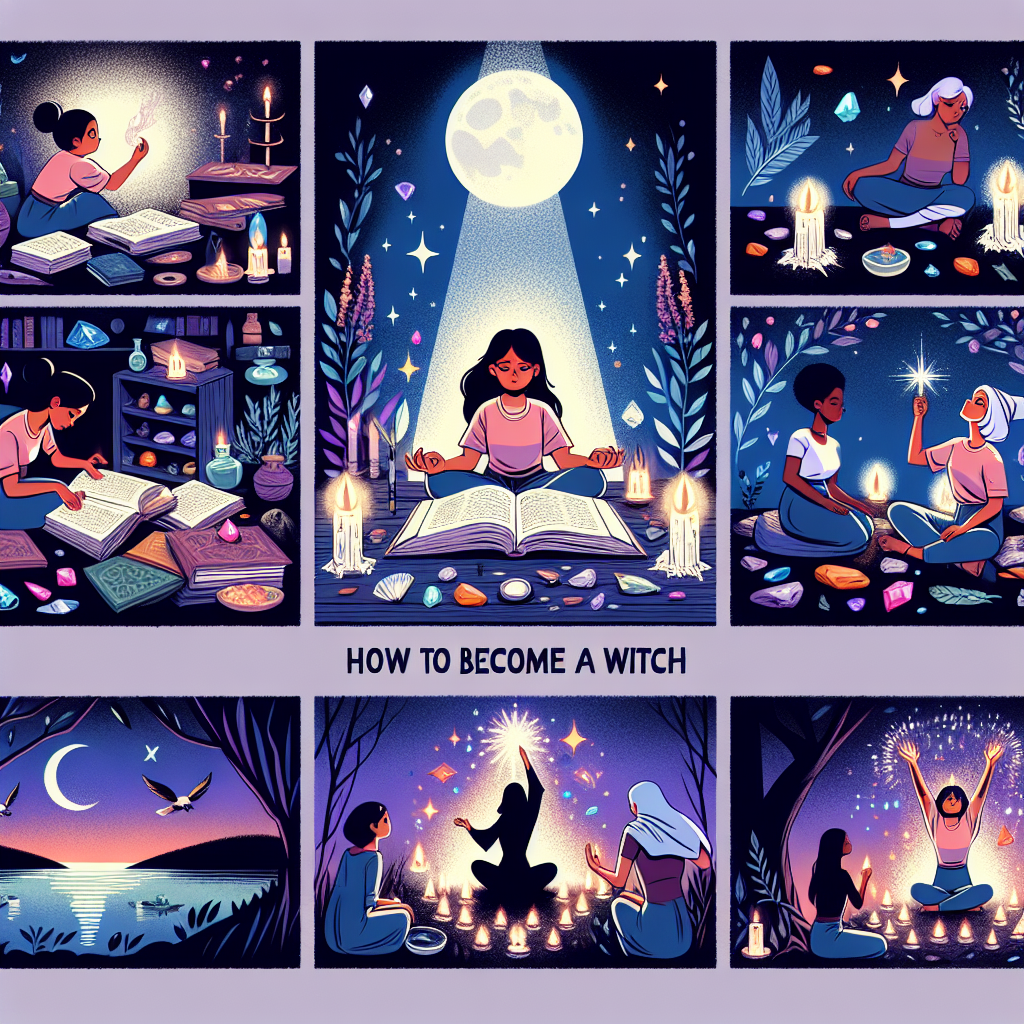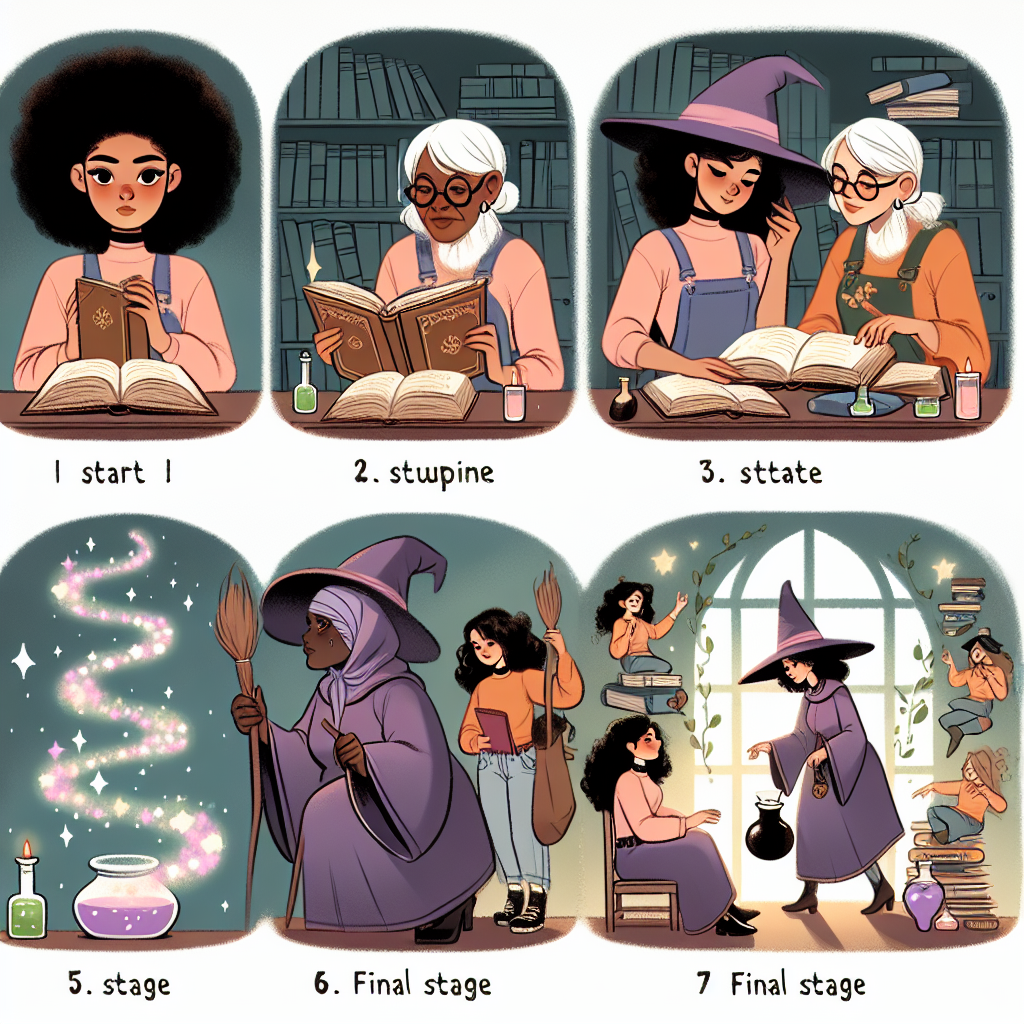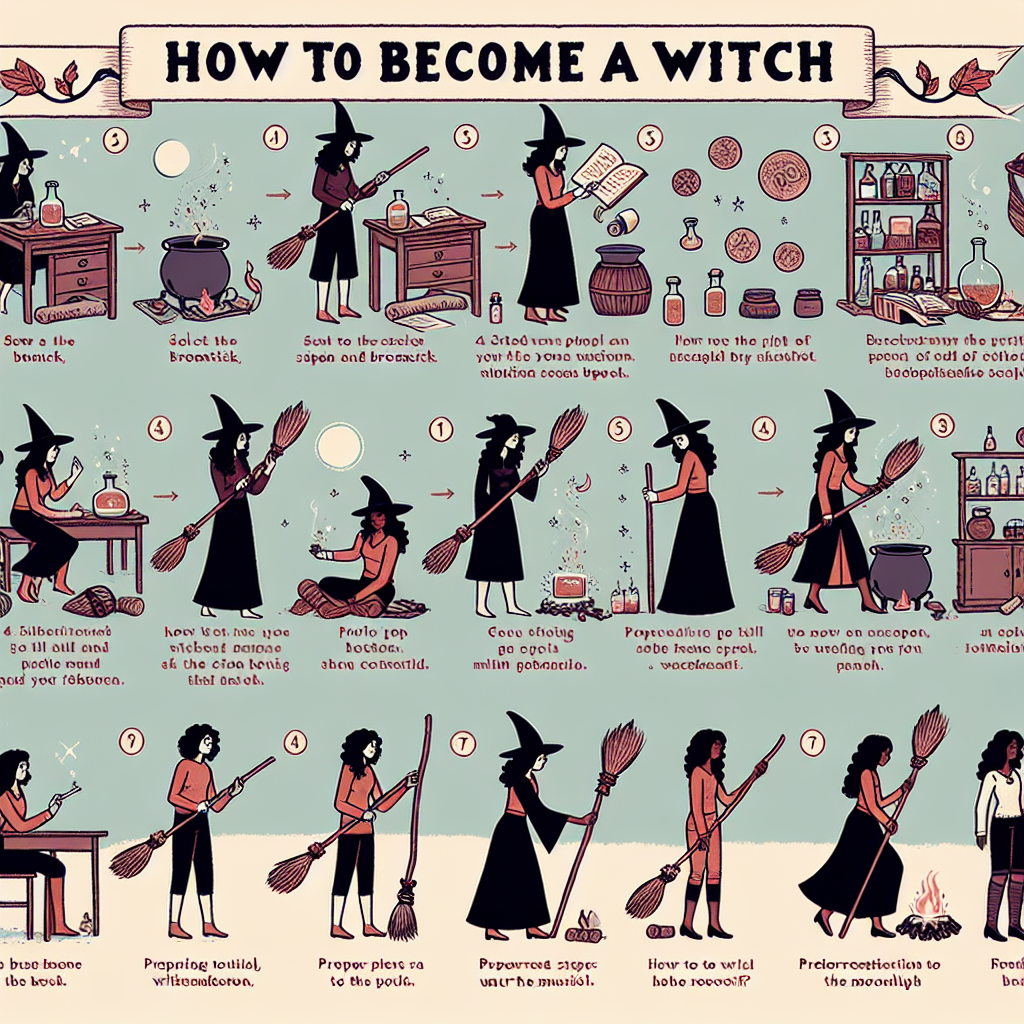As an Amazon Associate I earn from qualifying purchases.

Ever cast a wish upon a shooting star, hoping it would come true? Well, in the world of witchcraft you don't wish upon a star, but instead summon your intentions and channel your energy into tangible forms of transformation. Broadly speaking, becoming a witch involves cultivating an intimate understanding and harmonious balance with nature, its cycles, and the unseen metaphysical forces at play.
Swirling amidst the annals of history, steeped in suspicion and intrigue, the witches were habitually feared or reviled as dealers of dark magic. However, attempting to understand the witch in a contemporary context involves shedding these antiquated interpretations. Modern witches often identify less with broomsticks and pointy hats, and more with concepts like intuition, mindfulness and healing. An increasing number of people in recent years have regarded witchcraft as a viable and fulfilling spiritual pathway, an avenue to self-help and development, and a means of reclaiming their own power.
The ‘how' of becoming a witch varies with the culture and beliefs of the practitioner. Some people discover witchcraft in their roots, handed down generations or reintroduced through cultural reclamation. Others might be drawn to it by anyearning for spiritual connection or an expression of feminist autonomy. It's estimated that there are approximately 1.5 million witches in the USA alone. With this rise in the number of self-identified witches, the resurgence of witchcraft in mainstream culture is an undeniable fact.
Initiating your journey to become a witch is less about a singular grand ceremony and more about accumulating a wealth of knowledge on various aspects. At the heart of this process is defining the word ‘witch' for yourself. What does being a witch mean to you? Are you interested in the traditional, community-based practices of hedge witches, or are you drawn to the solitary path of the hermit witch? Or maybe it's the occult and highly structured system of ceremonial magic that captivates you.
Stepping into witchcraft also encourages you to develop a connection with the natural world. This includes understanding the cycles of the moon, the power of seasonal shifts, and the properties of herbs, rocks, and other natural elements. Many witches also use tools as symbols in their practice, like the pentacle, chalice, wand, or athame (a double-edged knife). As you delve deeper into witchcraft, you decide which tools resonate with you and how you want to use them in your practice.
Becoming a witch also means knowing your way around a spell. Spells are like symbolic, intention-driven recipes. They are not always about invoking supernatural forces but more so about directing personal energy and concentration toward a goal or outcome. Crafting a spell can be as simple as lighting a candle for clarity, or as complex as performing a multi-day ritual for love or prosperity.
Barking up your knowledge about witchcraft also means embracing a willingness to learn and constantly adapt. Witchcraft is a personal journey, not a monolithic structure. You are continually growing and changing, and so is your practice. Keep in mind that taking up the mantle of being a witch is more than just glamorous ritual and moonlit spellcasting, it includes hard work, study, introspection, and accountability.
In the pursuit of becoming a witch, remember that there is no definitive path. Just as every witch is unique, every witch's practice is individualistic too. Make space for exploration, mistakes, and growth. All you need to start is a genuine interest, an open mind, and a respectful approach to the tradition. The beauty of witchcraft is its fluidity, making it accessible to all who feel called to its path. There is no wrong way to be a witch; there are as many ways to be a witch as there are witches in the world.
What are the Steps to Embarking on the Path of Becoming a Witch?
Aspiring to tread the path of witchcraft, also known as Wicca, takes more than just a fleeting fascination. It demands commitment, study, and practice. Before one can become a witch, they must have a profound understanding of the craft's philosophical underpinnings, historical background, and various traditions. Although there's no standard method, potential practitioners should immerse themselves in comprehensive research, involving a broad spectrum of books, seminars, and workshops. Participating in gatherings allows them to connect with like-minded individuals and learn from experienced witches. More importantly, they must attune themselves with nature, as it is fundamental in witchcraft. Continue reading to discover the nuanced steps involved in becoming a full-fledged witch and successfully harnessing the power of the craft.
Understanding Witchcraft
The journey on how to become a witch is both personal and varied. It starts with a fundamental understanding of the different kinds of witches, which include, but are not limited to, green witches, hedge witches, hereditary witches, kitchen witches, and sea witches. These different types are characterized by the fate of their practice, their central beliefs, and the sources of their power.
Understanding the different types of witches helps one strategically align with the most suited kind based on your moral code, personal beliefs, and innate instincts. Therefore, your first step in becoming a witch should be research – read books, scan websites, join forums, or connect with existing witches. Important books to start with include “The Witch's Book of Shadows,” “The Witch's Eight Paths of Power,” and “The Inner Temple of Witchcraft.”
Develop Your Path
After you have a feel for where your tendencies lie, you’ll want to develop your path further. This is a process that will require intuition, self-reflection, and patience. Meditating and journaling can be beneficial for opening up your spiritual communication and will aid in your self-discovery as you determine your path as a witch.
Acquire and Learn Symbols
The study of witchcraft involves learning about various symbols used in the craft. Witches use symbols to represent different aspects of their faith and practice. You will need to learn what these symbols mean and how to use them properly.
Learn and Practice Rituals
Witchcraft involves many rituals, which are structured and repeated activities used to create a mood or mindset, make contact with the spiritual world, or achieve a specific result. These rituals usually involve spell-casting. Exploring and understanding your own energy, the moon cycles, and the power of natural elements is key to learning rituals.
Witchcraft Tools
Like any profession or hobby, witchcraft requires certain tools. These will depend on the type of witch you aspire to be. Typical tools might include items such as candles, a chalice, a cauldron, a pentacle, a wand, and a broom (besom), among many others. It is essential to understand why these tools are used, what they represent, and how to properly store and care for them.
Join a Coven or Practice Solo
While some witches prefer to join a coven and practice their craft collectively with like-minded souls, others prefer solitariness. Whichever is more aligned with your comfort zone is completely valid. Witchcraft is a very personal journey.
Embrace Learning
The path to becoming a witch is not a destination; it’s a never-ending journey of exploring, learning, and evolving. You don’t simply “become” a witch; you continue to grow into one by connecting with the universe and constantly seeking wisdom.
An analysis by the Pew Research Centre suggests that around 1.5 million Americans identify as Wiccan or pagan, a number that indicates an increasing interest in nontraditional, earth-based spirituality. As such, the path to becoming a witch is ever evolving and expanding.
1.
What does it mean to become a witch?
Becoming a witch means embracing witchcraft, which is a practice of magical skills, spells, and abilities. It entails a deep connection with nature and the spiritual world, alongside self-awareness and harnessing internal energy.
2.
Do you have to be born a witch to practice witchcraft?
No, anyone can practice witchcraft if they choose to. Some people may have a lineage of witches in their family, but this isn't a prerequisite. Witchcraft welcomes all who genuinely wish to learn and harness its practices.
3.
Are there different types of witches?
Yes, there are numerous types of witches. Some are Green Witches who focus on nature, Kitchen Witches who incorporate witchcraft into home and hearth, Hedge Witches who traverse between the spiritual and physical world, and many more.
4.
Do I need to join a coven to become a witch?
No, while some witches choose to join covens for a sense of community and shared learning experiences, others prefer to practice alone as solitary witches. It's largely a personal choice.
5.
What are some basic tools or items I might need to begin practicing witchcraft?
Typical tools can include an athame (ritual knife), a wand, a chalice, a pentacle, and stones or crystals. However, these are often more symbolic and not strictly necessary to practice witchcraft. Each witch has personal preferences and adapts to what feels right for them.
6.
Is witchcraft considered a religion?
While many witches may follow a specific religious path like Wicca, not all witches are religious. Some simply view witchcraft as a practice or a way of life, not necessarily a religion.
7.
Are there specific books or resources that can aid me on my path to becoming a witch?
Yes, there are many books available that delve into various aspects of witchcraft such as ‘Witchcraft Today' by Gerald Gardner or ‘The Modern Witchcraft Guide to Magickal Herbs' by Judy Ann Nock. Online resources, courses, and community forums can also be very helpful.
8.
Does it cost a lot of money to become a witch?
No, becoming a witch doesn’t need to cost anything. While there are optional resources and tools that can be purchased, witchcraft doesn’t require expensive tools. Much of it relies on personal energy, intention, and connection with nature.
9.
Are there any risks or dangers involved in practicing witchcraft?
Like any practice involving the spiritual or unseen world, it's important to protect oneself and proceed with respect and caution. Negative effects are often the result of unprepared or irresponsible use of witchcraft, but these risks can be effectively managed with correct knowledge and practice.
10.
How long does it take to become a witch?
There's truly no set timeline. For some, it takes months of study and practice, for others it might be years. It's a personal journey deeply tied to your own spiritual growth and understanding.

Conclusion on How to Become a Witch
In conclusion, becoming a witch is a deeply personal journey that varies greatly between individuals. At its core, witchcraft is about connecting with the natural world, the divine, and harnessing one's own personal power to enact change. Starting with basics such as meditation, energy sensing and grounding, and shadow work can prepare aspirants for this path. Acquiring knowledge on herbs, crystals, candles, and their respective energy as well as understanding the phases of the moon can highly contribute to a firm groundwork for your craft. Likewise, developing specific practices methodologies such as divination or spellcasting require extensive study and practice.
Witchcraft is not confined to any religion but is often associated with paganism, Wicca or other spiritual paths. Engaging in the community either in person or through online platforms like social media can help on practitioners' journey. Throughout this transformative journey, making a personal commitment to the path and respecting all life forms is the core principle. Furthermore, adopting ethical considerations like free will, consequential thought, and the principle of return (the idea that the energy we put out into the world, both good and bad, returns to us threefold) is fundamentally important to witchcraft. Remember, the journey to becoming a witch is about growing and evolving as a spiritual being.
Amazon and the Amazon logo are trademarks of Amazon.com, Inc, or its affiliates.


